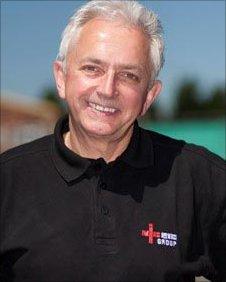'Minutes after surgery I was pain free'
- Published

The stabbing pains in Bill Attew's face were excruciating - so severe that at times he wished he could go to sleep and never wake up.
What had started as a 'niggly' feeling in his cheek had rapidly worsened and led to two years of intense pain.
He had to stop working, phone calls were too painful to take and eventually even eating and drinking became too painful.
Doctors quickly diagnosed trigeminal neuralgia - caused when a blood vessel presses on a nerve, sending the wrong messages to the brain.
Increasing pain
But no treatment seemed to work and Bill, aged 58, from Middlesex, found himself being passed from hospital to hospital.
"I had a dreadful pain in the left hand side of my face," he said.
"The pain was so bad that if I was driving I had to just pull over to the kerb or someone's driveway.
"My gums hurt. I was burning my gums, putting oil of cloves on them and drinking whiskey, but nothing helped.
"I couldn't even touch my head. Even somebody walking past and the friction would set my face off. I couldn't talk or drive.
"I wasn't going to kill myself, but I thought if I don't wake up then OK.
"One day I was in so much pain that I couldn't move my eyes. I was dribbling out of my mouth. I couldn't swallow."
TV clue
Then a friend of Bill's told him about an operation he had seen on TV - where a woman with a similar condition was cured.
The friend traced the clip through the internet, and Bill made contact with the Spire Hospital in Bristol.
A week after his initial consultation Bill was booked in for an operation. As soon as he came round he noticed that the pain had vanished.
"As I came out of theatre, I thought 'he's done it'," he said.
"There was no pain and I needed no painkillers. "
Consultant Mr Nik Patel said Bill's pain had been caused by a blood vessel pressing on the trigeminal nerve. He performed an operation to decompress the nerve - easing the pressure and lessening the pain.
"It is a quite rare, but potentially underdiagnosed condition," said Mr Patel, a consultant neurosurgeon.
It is estimated that 1 in 15,000 people suffer from trigeminal neuralgia.
"A lot of people would visit many practitioners before the condition is labelled and because it is quite rare a lot of people may not have seen a case to be able to diagnose it.
"There is better awareness now though than in the past.
"In the majority of cases it is because a blood vessel is pressing on the trigeminal nerve - the largest of the brain nerves and it serves two functions - to transmit sensory functions from the face to the brain, specifically touch and pain. It also supplies the muscles that help us chew."
He said the pain was probably "the worst pain imaginable".
"When treatments were not available or diagnosis not reached it was common for people to take their lives because living with this pain was such an ordeal."
Relatively unknown
And he said that although the operation has been carried out for over a decade it was still not widely known, with only a handful of surgeons carrying it out.
Jillie Abbott, chairman of the Trigeminal Neuralgia Association, agreed: "Thankfully, the incidence of Trigeminal Neuralgia (TN) is rare but because of this the association struggles to get its message out to GPs, dentists and specialists, many of whom are shockingly ignorant about the condition and its treatments.
"We constantly give presentations and exhibit at medical conferences across the country.
"These efforts are starting to reap rewards, as we can tell from the number of people who contact us who are now being managed effectively.
"But many others who could be fast-tracked for surgery are just being prescribed higher and higher doses of drugs, and are left to suffer in pain."
Mr Attew said his life had been completely transformed.
"I went back to see Nik Patel and told him I felt wonderful, and that's how it has been in the nine months since."
- Published22 February 2010
- Published24 May 2003